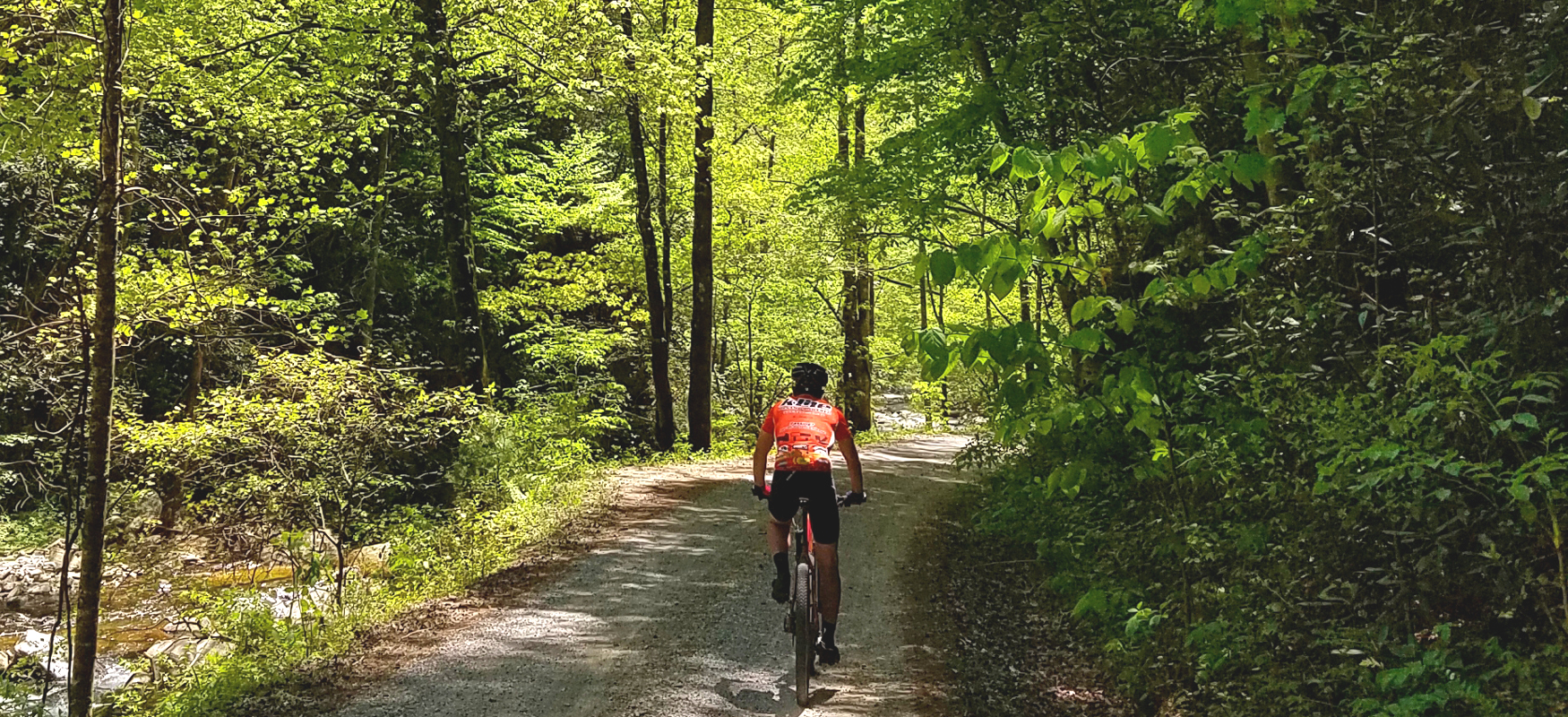47 Miles / 5800 Feet of Climbing
Enjoy pristine gravel roads, beautiful scenery and a dramatic finish crossing over the Hiwassee River on a suspension bridge on this challenging mountain loop!
Potential Route Modifications: This route can be shortened by 6 miles by taking a left at mile 13.7 at Smith Mountain Road and taking it about 7 miles to Kimsey Mountain Hwy where you can turn left to continue on the regular route.
If you're looking to go deep into the woods and push your legs with a lot of climbing, this is the ride for you. This ride also features a beautiful suspension bridge across the Hiwassee River!
There are a number of places to start this ride, depending on what you're looking for when you get back. We've mapped it from the parking lot at the Hiwassee State Scenic River access parking lot, but you could just as easily start from Flip Flop Burgers, Webb Brothers or Reliance Fly & Tackle.
Regardless of where you start from, the first part of the ride will be on Hwy 30, which may have a few fast-moving cars, so use caution while riding on it. After a mile and a half on Hwy 30, you'll turn left onto Lost Creek Road and plunge into the forest where you'll ride for the next 40 miles!
About 4 miles after passing the Lost Creek Campground look for Forest Road 23 and take a right. Forest Road 23 will have you rolling along for around 5 miles of up and down before it starts to head uphill on a sustained climb. A mile later you'll run into Forest Road 68 (also known as Kimsey Mountain Hwy), where you'll turn left and continue the climb for another 6 miles!
After cresting Kimsey Mountain, you'll begin a long and well-deserved descent. As you're heading down, look for Forest Road 99 (also known as McFarland Road) on your left. This turn is shortly after mile 27, and you won't want to miss it as you're rolling down the hill!
After four and a half miles on McFarland Road, you'll veer left onto Forest Road 236 and continue your descent off the mountain following Wolf Creek almost all the way down to the Hiwassee River where the road will bend to the left and start to head uphill. Shortly after you start the climb (around mile 36.5), look for a pipe spring where you can fill up your water bottles!
Your journey through the woods will end in dramatic fashion after mile 41 when you pop out at a suspension bridge that crosses over the Hiwassee River. It makes for a great finish to the forest and a beautiful photo op at this bend in the river. It also connects you to the rolling tarmac of Powerhouse Road that runs along the river and leads you back to the ride start in Reliance.
While Reliance doesn't look like much today, it has an interesting history and was listed in the National Register of Historic Places in 1986. The 1912 bridge has been replaced, but there are still four buildings in the area that were built before the turn of the 20th century: The Watchman’s House, now available for rentals; the Vaughn-Webb house, still a family residence; the Hiwassee Union Church, now available for weddings and special events; and the Higdon Hotel.
Historic stone walls still stand, as does a fish weir used by Cherokee to trap fish. Early farm buildings adorn the corn field. A general store, celebrating its 7th anniversary, offers rafts, tubes and funyaks for fun on the Hiwassee as well as cold drinks, snacks and souvenirs.
The district was listed on the National Register because of its local architectural and historical significance and the fact it represents a significant and distinguishable entity which conveys a sense of time and place.
While settlements were taking hold in other parts of the county and Benton was being developed, the Reliance area was still occupied by the Cherokee. The earliest known settlers of record were T.A. Toomey and D.A. Haskins, who established farms south of the river. Elisha Dodson purchased most of Toomey’s holdings, including a water-powered grist mill and saw mill located near the bridge. This mill, commonly called Dodson’s Mill, ground grain for farmers in the surrounding area and turned freshly-cut logs into lumber and became the center of what would become Reliance.
Dodson’s slave Carol supervised Cherokees who had escaped the Removal in the construction of the stone walls that still stand. Carol also helped build the first mill on the river, cast its wheels, built its rock dam and tended the grinding. When he married Lindy, another slave, Dodson freed them both as a wedding present.
Around 1880, Joseph Dallas Vaughn purchased Dodson’s Mill and other tracts to create the largest and most productive farm in the area. Early settlers relied on farming and timber as their primary sources of income, with the main crops - then as now - being corn and hay.
Reliance was located along a mail route and area mail was left with Sarah Reed Vaughn, whose daughter Alice married into the Webb family, which still owns the family farm.
In the late 19th Century, the arrival of the railroad and river ferry and the location of nearby logging camps helped Reliance develop into a small commercial and social center for the surrounding area. By the early 20th Century, a bridge replaced the ferry as the main form of transportation across the river.
A community building, an early resident’s farm, two buildings associated with the railroad and the bridge combined to form the historic district. All of the historic buildings are of the same material and scale, while the Vaughn-Webb House and Higdon Hotel display interesting sawn wood ornamentation.
The Vaughn-Webb house, located on Hwy 30, was built in the late 1880s. In addition to operating a grist mill, the Vaughn family grew corn and hay, raised cattle, hogs, and mules, and cut timber. Stones from the grist mill can be seen at Webb Brothers Store, and cattle can still be seen in the fields.
The Higdon Hotel was built by Calvin Higdon on the north side of the river after the L&N Railroad purchased right-of-way for track construction in 1888. The large two-story frame hotel with a two-story front porch provided accommodations for the railroad personnel and travelers. It is located on Childer’s Creek Road just a short distance away from the north end of the bridge on Tellico-Reliance Road/315.
The Watchman’s House was built in 1891 for use by the railroad watchman, who checked the railroad bridge for burning embers after the train passed over. It is located just across the bridge.
The Hiwassee Union Church and Masonic Lodge joined forces around 1899 to build a two-story frame building with a full porch across the front. The upper floor was used by the Masons, with the church meeting on the first floor. During the week, the church was used as a school for a short time.
During the first decade of the 20th Century, the forests attracted the attention of large timber companies. The Pendergast Lumber Company built a logging camp called Probst about a mile upriver from Reliance. At its peak, there were more than 25 buildings in Probst. Several families of the workers lived as tenants on the Vaughn-Webb farm. Over the years, several store sites were operated by various tenants on the farm.
Changes took place between 1915 and 1930. The mill burned in 1915, although it was rebuilt and continued to operate into the 1940s. Much of the timber supply was exhausted and the Probst camp closed. With the increasing use of automobiles, fewer passenger trains stopped in Reliance and the hotel ceased to operate around 1920.
The grandsons of Joseph and Sarah Vaughn opened Webb Brothers’ Store on May 15, 1936 to serve as general store, post office, gas station and library. Still in existence, it is now housed in a 1955 building. The mill was demolished in the 1950s, and both the church and Masons ceased using the 1899 building in the 1960s.
In 1969, a whitewater rafting service was begun by the Webb family, bringing a new era of activity to the community, which still retains its historic character.
For even more gravel routes, check out TennesseeGravel.com!

